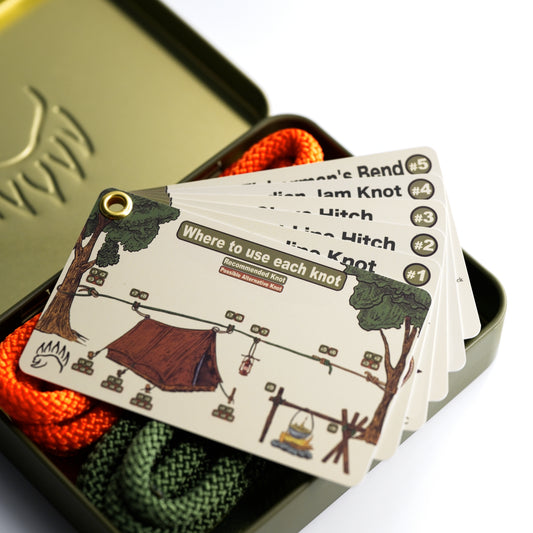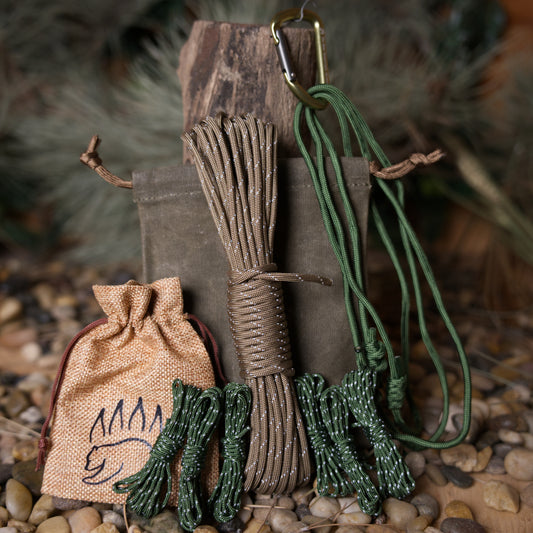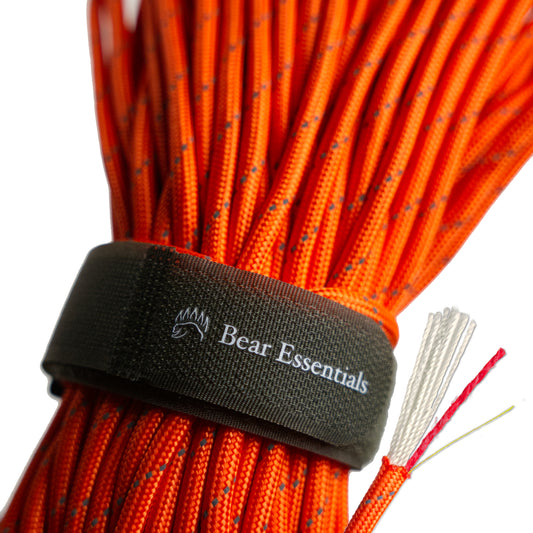How to Tie the Trucker’s Hitch - Double Dragon Variation
Usage
The Trucker’s Hitch - Double Dragon Variation is commonly used to tension ropes for securing loads, such as tarps or gear in camping and bushcraft. Unlike the Slipknot Variation, which can bind tightly, this version uses a Double Dragon loop for a non-jamming, in-line pull that’s easy to untie after heavy strain. Its pulley-like system provides excellent tension, though it requires practice to tie efficiently. It’s ideal for creating taut shelter lines but needs sufficient rope length.
Why Learn the Trucker’s Hitch - Double Dragon Variation?
- Non-jamming loop: The Double Dragon loop stays easy to untie, even after heavy loads.
- In-line pull: Aligns perfectly for directional tension, reducing rope wear.
- Strong tension: Provides a 3:1 mechanical advantage for secure tightening.
- Versatile applications: Suits tarps, shelters, or hauling in rugged environments.
- Quick setup: Allows tension adjustments without retying the knot.
Common Uses
-
Scouts:
- Secures gear for pioneering structures.
- Tensions ropes for camp setups.
-
Camping:
- Tightens tarps for wind-resistant shelters.
- Secures guylines to stakes for tents.
-
Bushcraft:
- Hangs food bags away from wildlife.
- Builds taut lines for sturdy shelters.
-
Search and Rescue:
- Hauls equipment in technical operations.
- Secures loads for stable transport.
ABOK Number
(Ashley Book of Knots)
Other Names
Category
|
How to Tie the Trucker’s Hitch - Double Dragon Variation
- Create a Double Dragon loop mid-rope by wrapping the rope around your hand twice, tucking the second loop through the first, and pulling tight.
- Pass the working end through an anchor point, such as a stake, tree, or ring.
- Thread the working end back through the Double Dragon loop.
- Pull the working end to tighten the system, creating strong tension.
- Lock the working end with two half hitches around the standing line.
Tips:
- Ensure the Double Dragon loop is snug before loading to prevent slipping.
- Use a low-stretch rope, like nylon, for smoother tensioning.
- Practice the loop-tying technique for faster setup in the field.
Variations
Trucker’s Hitch - Alpine Butterfly Variation vs. Trucker’s Hitch - Double Dragon Variation
- Pros: Simpler to tie and more widely known among outdoor enthusiasts.
- Cons: Less ideal for in-line pulls, which can cause slight rope twist.
Trucker’s Hitch - Prusik Variation vs. Trucker’s Hitch - Double Dragon Variation
- Pros: Allows sliding the loop for precise positioning along the rope.
- Cons: Requires a separate cord, adding complexity and weight.
Similar Knots
Trucker’s Hitch - Slipknot Variation vs. Trucker’s Hitch - Double Dragon Variation
- Pros: Faster to tie for quick setups in non-critical applications.
- Cons: Slip knot jams tightly, making it hard to untie after heavy loads.
Poldo Tackle vs. Trucker’s Hitch - Double Dragon Variation
- Pros: Adjustable loops allow dynamic tensioning for specific tasks.
- Cons: More complex and requires extra rope compared to the Double Dragon.
History and Origins
The Trucker’s Hitch traces its origins to maritime and transport industries, where securing cargo was essential for sailors and teamsters. The Double Dragon Variation likely emerged in modern outdoor contexts, leveraging the secure, non-jamming Double Dragon loop (referenced in knot-tying communities for its strength). Its adoption in bushcraft, camping, and scouting reflects its reliability for tensioning lines in diverse outdoor settings.
Security Level
The Trucker’s Hitch - Double Dragon Variation is highly reliable for tensioning under moderate to heavy loads when tied correctly. The Double Dragon loop resists jamming, ensuring easy untying after strain. For slippery ropes, adding an extra wrap in the loop can enhance grip. A stopper knot after the half hitches boosts security for critical applications such as the stevedore stopper knot or the ashley stopper knot
Downsides
- Skill required: Tying the Double Dragon loop smoothly takes practice.
- Rope length: Requires more rope than simpler hitches for the loop and anchor.
FAQ
Is the Trucker’s Hitch - Double Dragon Variation strong enough for heavy loads?
Yes, it’s robust for tarps, gear, or rescue tasks when tied properly, but always inspect the rope and anchor.
What rope works best for the Trucker’s Hitch - Double Dragon Variation?
Low-stretch ropes like nylon or polyester ensure secure, smooth tensioning.
How does the Trucker’s Hitch - Double Dragon Variation compare to the Alpine Butterfly version?
It’s better for in-line pulls and resists jamming, but the Alpine Butterfly is easier to learn.
Can the Trucker’s Hitch - Double Dragon Variation be used for climbing setups?
It’s suitable for tensioning systems in climbing camps, not for primary anchors.
Why use the Trucker’s Hitch - Double Dragon Variation instead of a ratchet strap?
It’s lightweight, adjustable, and ideal for remote settings without needing extra hardware.
Important Notes on Safety
- Common failure points include an improperly tied Double Dragon loop or a weak anchor. Always ensure half hitch security by checking the loop is secure and the anchor is solid before applying tension.
- Inspect the rope for wear or fraying before use.
- Use at least two half hitches to lock the system securely.
- Practice tying in low-risk settings to build confidence.







